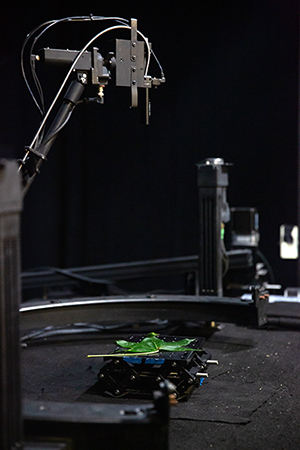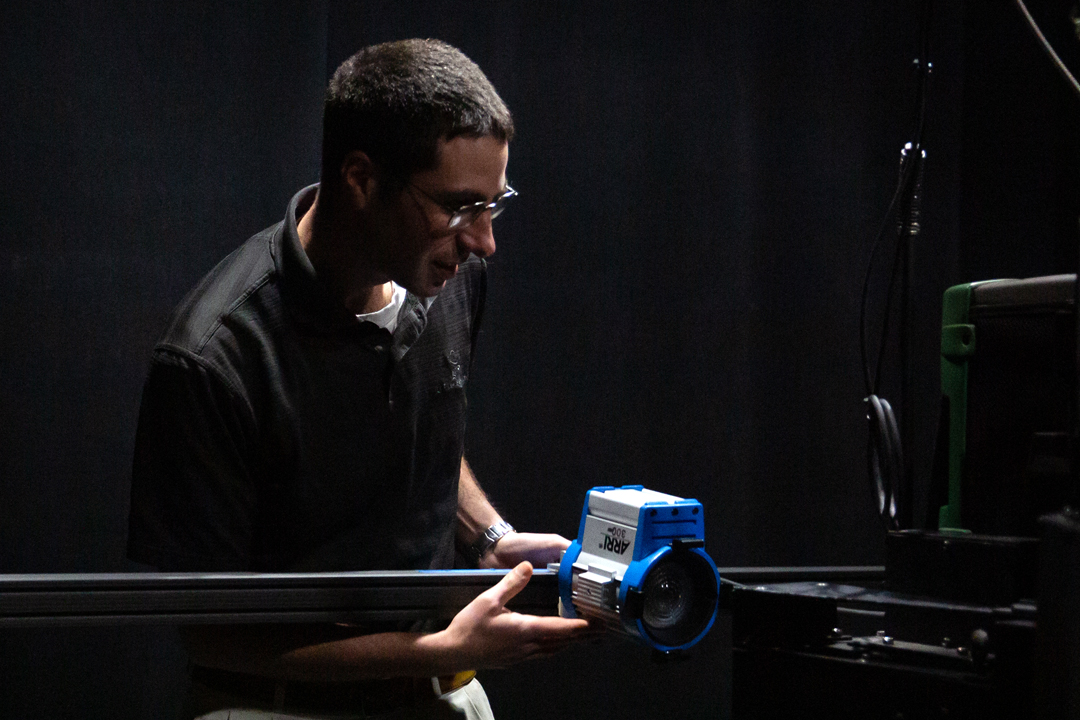Student to Student: Remote Sensing
By Benjamin Roth
Jaime Huynh, RIT Student
Benjamin Roth is a third-year Imaging Science Ph.D. Student in the Chester F. Carlson Center for Imaging Science.
Who are your mentors/advisors?
My advisor is Jan van Aardt, a professor in the Chester F. Carlson Center for Imaging Science. Others who were instrumental in my success include Professor Charles Bachmann, Principal Scientist Scott Brown, and Senior Research Scientist Adam Goodenough.
Can you tell us more about your research?
 My research focus is on retrieving accurate biophysical information on forest health from remote sensing platforms. Specifically, I am studying the effects leaf optical properties have on signals received from these systems. We have a responsibility to actively monitor the health of the world’s ecosystems, given global climate change, land use and land cover change, and invasive species impacts, to name a few. Remote sensing, specifically for vegetation health assessment from airborne and satellite platforms, is the most efficient and practical way to accomplish large scale monitoring. It is in this context that a better understanding of light interactions with leaves allows for the exploitation of current remote sensing technologies and the development of new sensors for ecological applications. Incorporation of more realistic leaf optical properties into radiative transfer models is especially important, as these simulations are often used in the development of algorithms to exploit current remote sensing data, as well as aid in the development of new sensors. Radiative transfer models allow for experimentation on different imaging sensors in a simulation environment, such as high resolution, multispectral, or hyperspectral systems, as well as light detection and ranging (lidar). If these sensors are being designed specifically for vegetation monitoring, leaves must be accurately modeled.
My research focus is on retrieving accurate biophysical information on forest health from remote sensing platforms. Specifically, I am studying the effects leaf optical properties have on signals received from these systems. We have a responsibility to actively monitor the health of the world’s ecosystems, given global climate change, land use and land cover change, and invasive species impacts, to name a few. Remote sensing, specifically for vegetation health assessment from airborne and satellite platforms, is the most efficient and practical way to accomplish large scale monitoring. It is in this context that a better understanding of light interactions with leaves allows for the exploitation of current remote sensing technologies and the development of new sensors for ecological applications. Incorporation of more realistic leaf optical properties into radiative transfer models is especially important, as these simulations are often used in the development of algorithms to exploit current remote sensing data, as well as aid in the development of new sensors. Radiative transfer models allow for experimentation on different imaging sensors in a simulation environment, such as high resolution, multispectral, or hyperspectral systems, as well as light detection and ranging (lidar). If these sensors are being designed specifically for vegetation monitoring, leaves must be accurately modeled.
Lidar remote sensing has shown high accuracy/precision for the quantification of forest biophysical parameters needed for ecological management. Although the significant effect of Bidirectional Scattering Distribution Functions (BSDF) on remote sensing of vegetation is well known, current forest metrics derived from lidar data seldom take leaf BSDF into account. Despite the importance of BSDF effects, leaf directional scattering measurements are almost nonexistent, particularly for transmission. We captured deciduous broadleaf BSDFs from the visible through shortwave infrared spectral regions, accurately modeled the BSDF for extension to any illumination angle, viewing zenith, or azimuthal angle.
The goniometer of the Rochester Institute of Technology-2 (GRIT-T) was used to make leaf bi-conical directional reflectance and transmittance measurements. Leaves from three species of large trees, Norway Maple (Acer platanoides), American Sweetgum (Liquidambar styraciflua), and Northern Red Oak (Quercus rubra) were measured (right). Data then were fit through nonlinear regression to physical-based microfacet BSDF models. Leaf physical parameters, including the index of refraction and a relative physical roughness, were extracted from the microfacet models delineating the three species. The leaf models were then inserted into the Digital Imaging and Remote Sensing Image Generation (DIRSIG) model, developed by Rochester Institute of Technology, to study the effects on remote sensing signals when monitoring forest canopies.
How did you come to study Imaging Science at RIT?
Studying and receiving a doctoral degree has always been in the back of my mind. I enjoy teaching others about math and science, and I knew if I ever wanted to teach at the collegiate level, a doctoral degree would greatly benefit in this pursuit. I am an active duty Air Force service member, and an opportunity was advertised to me where my degree would be paid for and I would be given a salary. The program advertised, Imaging Science, I knew very little about, but I was very interested in given my undergraduate and master’s degree in physics. I was accepted to the program, and here I am.
How did you become interested in remote sensing?
I became interested in remote sensing, specifically for forestry applications due to my advisor Jan van Aardt. He is a very outspoken and motivating speaker. I never knew looking at trees could be so interesting before I met him. I became fascinated by how we could decipher so much about the trees, and ecosystems in general, from sensors looking down from distances of thousands of meters in the atmosphere, or even hundreds of kilometers in space.
Do you have any other research experience you would like to share?
I have had to overcome many obstacles, having to repeat lab measurements numerous times. On one occasion of repeating measurements, the broad-spectrum halogen lamp I was using for each measurement was no longer working. When performing experiments, it is imperative to keep the lab set up the same each time, except for the one variable you intend to change. The lamp manufacturer no longer made components for the lamp, and I was greatly discouraged that I would have to repeat many more experiments to figure out another lab setup that would work. After sharing the issue with other staff members, our building/lab manager Matthew Cassela helped isolate the issue to the power adapter, Colleen McMahon our staff assistant was able to purchase parts, and Dr. Bob Kremens shared extra equipment from his lab. With the help and input from others, the lamp was fixed, and data collections continued.
While performing research, especially lab experiments, it is easy to become discouraged. Well, this is part of the research, and if things are not going wrong, you are doing it wrong. What is important, is that you learn from what went wrong, and change what you do the next time around in a controlled manner. Also, it is important to scale experiments slowly, so the effects on individual components can be isolated. Don’t expect to take all your data in one shot, it is a process. Also, don’t be afraid to ask for advice and help.











